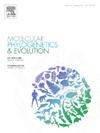The evolution of wasp mimicry and biogeography in the genus Temnostoma (Diptera: Syrphidae)
IF 3.6
1区 生物学
Q2 BIOCHEMISTRY & MOLECULAR BIOLOGY
引用次数: 0
Abstract
One of the most remarkable examples of Batesian mimicry occurs in the genus Temnostoma Le Peletier & Audinet-Serville, 1828 (Diptera: Syrphidae). Adults of this genus have an overall resemblance to hymenopterans combined with behavioural mimicry (they move the fore legs in front of the head mimicking hymenopteran antennae). While some species of Temnostoma are considered highly accurate mimics of social wasps, other species have a darker colour pattern and are rather relatively poor yellowjacket mimics. Both colour phenotypes are widespread through the Holarctic. Here, we infer for the first time the evolutionary history of the genus with special focus on the evolution of mimicry and biogeography.
With material covering 75 % of known species of Temnostoma and both colour phenotypes from each biogeographical region, we inferred a molecular phylogeny based on six molecular markers (mitochondrial protein-coding COI gene, nuclear 28 s rRNA gene, and four nuclear protein-coding genes: AATS, CK1, TULP, and RBP-15). Using Bayesian inference, we obtained a highly resolved phylogenetic tree supporting the monophyly of the genus Temnostoma as a sister group of genus Takaomyia Hervé-Bazin, 1914. Within Temnostoma, Te. daochus and Te. barberi (two Nearctic species with strikingly different mimicry patterns) were found to be closely related to each other and together form a lineage sister to the rest of the genus.
Our results suggest that the behavioural mimicry of wasp antennae is a plesiomorphic state inherited from a common ancestor that includes the genera Temnostoma and Takaomyia. Within Temnostoma, the dark colour pattern (poor yellowjacket mimicry) appears to be an ancestral state and highly accurate social wasp mimicry has appeared two times independently within the genus. In some species inhabiting northern parts of the Holarctic, secondary darkening and consequent degradation of the yellowjacket mimicry appeared. This indicates high evolutionary plasticity and ongoing selection pressure on morphological characters related to mimicry in hover flies.

双翅目:蠹虫科黄蜂的进化与生物地理。
贝氏模仿最显著的例子之一发生在Temnostoma Le Peletier & Audinet-Serville, 1828年(双翅目:蚜蝇科)。这一属的成虫总体上与膜翅目昆虫相似,并伴有行为模仿(它们在头部前移动前腿,模仿膜翅目昆虫的触角)。虽然Temnostoma的一些物种被认为是高度精确地模仿社会黄蜂,但其他物种的颜色模式较深,相对来说是相对较差的黄夹克模仿。这两种颜色表型在全北极都很普遍。在此,我们首次推断了该属的进化历史,并特别关注拟态和生物地理的进化。我们的材料覆盖了Temnostoma已知物种的75% %和来自每个生物地理区域的两种颜色表型,我们基于6个分子标记(线粒体蛋白编码COI基因、核28 s rRNA基因和4个核蛋白编码基因:AATS、CK1、TULP和RBP-15)推断了分子系统发育。利用贝叶斯推断,我们获得了一个高度解析的系统发育树,支持Temnostoma属是Takaomyia herv - bazin属的姐妹群,1914。在Temnostoma内,Te。道家和特。barberi(两种模仿模式截然不同的新北极物种)被发现彼此密切相关,并与该属的其他物种形成了一个谱系姐妹。我们的研究结果表明,黄蜂触角的行为模仿是从包括Temnostoma属和Takaomyia属的共同祖先遗传下来的一种多形态状态。在Temnostoma中,深色图案(可怜的黄夹克模仿)似乎是一种祖先状态,高度精确的社会黄蜂模仿在该属中独立出现过两次。在居住在全北极北部的一些物种中,出现了二次变黑和随之而来的黄夹克拟态退化。这表明悬停蝇与拟态相关的形态特征具有高度的进化可塑性和持续的选择压力。
本文章由计算机程序翻译,如有差异,请以英文原文为准。
求助全文
约1分钟内获得全文
求助全文
来源期刊
CiteScore
7.50
自引率
7.30%
发文量
249
审稿时长
7.5 months
期刊介绍:
Molecular Phylogenetics and Evolution is dedicated to bringing Darwin''s dream within grasp - to "have fairly true genealogical trees of each great kingdom of Nature." The journal provides a forum for molecular studies that advance our understanding of phylogeny and evolution, further the development of phylogenetically more accurate taxonomic classifications, and ultimately bring a unified classification for all the ramifying lines of life. Phylogeographic studies will be considered for publication if they offer EXCEPTIONAL theoretical or empirical advances.

 求助内容:
求助内容: 应助结果提醒方式:
应助结果提醒方式:


